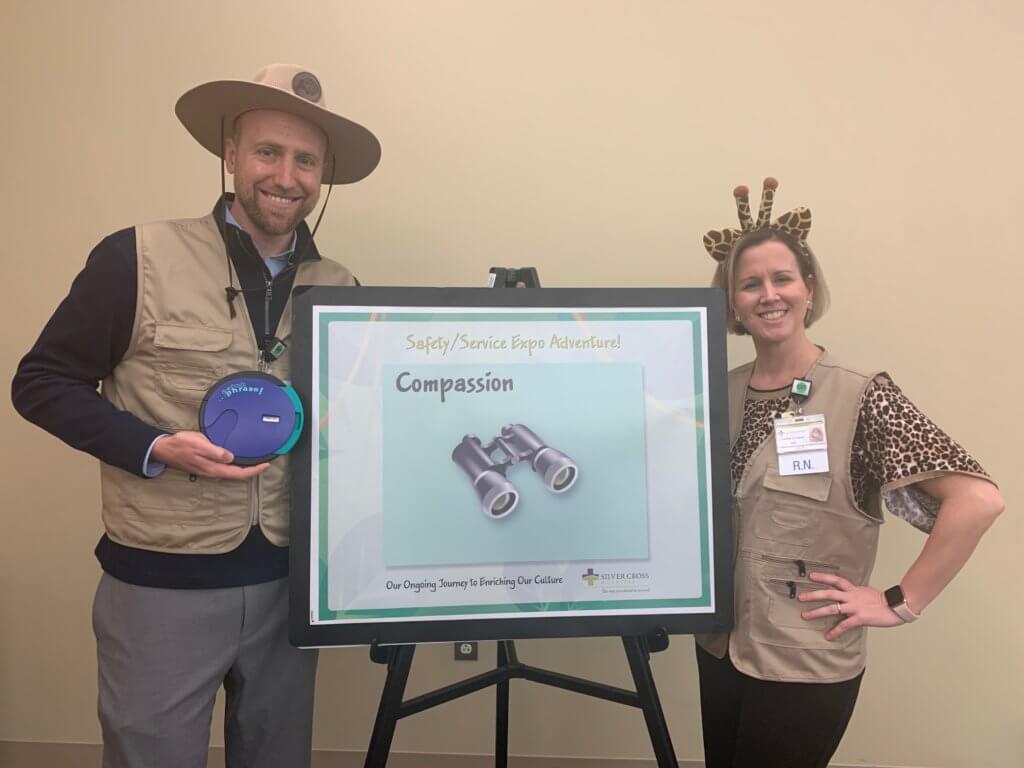
On the first Monday of every month, DTA convenes a community of Care Team Coaches from across the country. Our February call featured a presentation from Eric Danielson, Administrative Director of Medical Staff Services & Business Intelligence and Care Team Coach, and Leslie Johnson Manager of Quality and Patient Safety and Care Team Coach at Silver Cross Hospital in New Lenox, IL.
During our conversation with Eric and Leslie, they shared a bit about how coaching has been going in the organization and also some creative strategies on how they’ve incorporated the key care practices into the broader organization. Here’s part two of what Eric and Leslie had to share with the group.
DTA: Leslie, do you mind sharing what else you’re doing with some of the key care practices that we all use in Care Team Coaching?
LJ: Absolutely! Our CEO challenged us to incorporate compassion and the key care practices into our Safety and Service Expo. This Expo started on February 3rd and there will be 60 of these sessions between now and the beginning of April. This is designed so that all of our 2900 employees can each attend one session. Each of the 60 sessions is an hour long and includes stops at four booths.
The four booths include: Our seven behaviors and our safety habits, an overview of Workday (our new ERP system), and Compassion through Connection which is the booth that Eric and I created. In our booth we call the key care practices “compassion practices” and we show how they are aligned with our seven behaviors.
We know that some of these compassion practices are where we have opportunities to improve and where we can use them more consistently. A lot of this is new information for our staff and we had to design something that allowed them to learn quickly within their 10 minute stop at our booth!
We used the Cohort Profiles of those coached in the organization to date to help us determine what practices to focus on at the booth. We made sure to emphasize the strengths that we exhibit at Silver Cross things like connecting with the care team, explaining things clearly, acknowledging family, introducing ourselves, washing hands, knocking, actively listening, and smiling.
We also spent some time on the inconsistencies and opportunities that we have as well. These were things like asking patients’ permission before we check their blood pressure and which arm to put the cuff on, thanking them, making sure that they know the duration of the procedure that’s going to happen, asking open-ended questions, and making sure that they are mindful of their on and off stage presence.
To illustrate this in a fun manner and make it engaging, we focused on about eight of the practices which were each written on a card. We had participants read out loud a card about each of the care practices. This allowed them to get to know the care practice, become familiar with it and share some examples. Then, we went into our Catchphrase game. If you remember this game, we had the original version with a disc and a button on the side. It has a window through which a care practice is visible. The person with the disc in hand had to say a bit about that care practice and get their team members to guess which one it was. It’s a really fun and engaging way to be able to act out and say the compassion care practice and engage everybody!
DTA: Wait, so you actually made your own version of Catchphrase?! How did you do that?
ED: So that’s a bit of a touchy subject but I was the one who did it! I did find a template online that claimed to be able to help you create your own but it didn’t work! So, my first step was to figure out how many words are on a disc (72) and figure out how many go around the circle. Since 72 times five is 360 degrees, every word is rotated five additional degrees to the one before it. Then it was just a lot of trial and error and rotation to make the font fit the window!
DTA: That’s fantastic! What a great idea! So, were there any takeaways from your booth?
LJ: To close out the session, we really wanted to have a takeaway that emphasized that it is important to use open-ended questions. This was one of our opportunities we learned from our coaching data. So, we created the A&W Challenge. We talked to staff about how instead of saying “Is there anything I can do for you?” if you change the A to a W and make it a “What can I do for you?” it will be more open-ended.
To emphasize this, we gave each one of our employees a root beer candy as they left our booth to remember the A & W! Again, we have 10 minutes of time to make an impact with our staff. What we’ve found thus far has made an impact. We’ve seen the surveys that have come back after the Expo. One key question that employees respond to on their evaluation is “What will you be doing in relationship to a change in practice based on the hour you’ve spent in the Safety Service Expo today?” A lot of the feedback we’ve seen is things like:
- “I will provide compassionate care to my patients”
- “I will ask open-ended questions when I’m with my patients”
- “I will ask ‘What can I do for you today’ when I’m working with my patients.”
It’s definitely made an impact!
Thanks to Leslie and Eric for sharing some of their creative ideas for engaging staff around the key care practices. Thanks also to all of the participants of our monthly Coaching Community Calls! This format has been super helpful in collectively building the Coaching Community across the country. If you are interested in learning more about the DTA Coaching Reporting Tool (the use of which is common to all of the Coaches on these Community Calls), you’re in luck! Sign up to view a demo of DTA Healthcare Solutions’ Coaching Reporting Tool.
